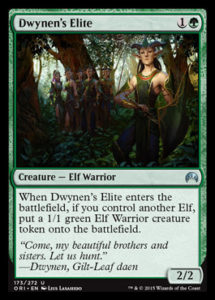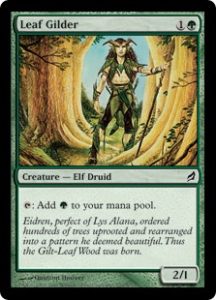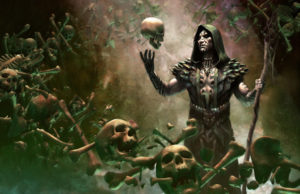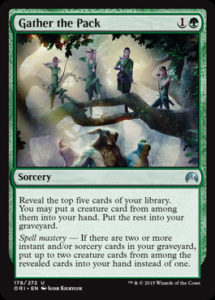The final Uncharted Realms in the series of planeswalkers’ beginnings takes us to Zendikar, where we meet a younger Nissa Revane amongst her tribe, the Joraga elves. After her animist powers and visions are believed to be associated with disaster, she is cast out, travelling with a companion through the lush jungle and fetid swamps of her plane’s home to the mountain range that imprisons the monstrous Eldrazi. With this revelation, Nissa is cast into the Blind Eternities, coming to rest on Lorwyn just before the magical Aurora tranforms it into the somber Shadowmoor. There, she sees her own kind on the hunt, slaughtering boggart “eyeblights” before tumbling back through the multiverse to return home.
Elves in History
Nissa’s elvish kind appear throughout legend, folklore, and religious teaching throughout the medieval Christian world, especially in Celtic, Anglo-Saxon, and Norse mythology. In various stories we can see the aspects of elves as they appear on both Zendikar and Lorwyn: beautiful and cruel, generous and malicious, attuned with the natural world but full of its danger for unwary humans.
The oldest tales of elves in the medieval North Sea area certainly predate the written record of medieval chronicles. These stories, categorized broadly as the Mythological Cycle, were recounted by bards and storytellers in Celtic, Teutonic, and Anglo-Saxon pagan tradition. With the arrival and growing popular acceptance of Christianity in northern Europe during the fifth to ninth centuries, the legends of the Mythological Cycle were recorded in feudal England, Ireland, and Denmark by cloistered monastic scholars. This written canon blended the newly arrived faith of Christianity with the supernatural motifs of its pagan predecessors and included heroic epics like the Norse Beowulf, chronicles of folklore such as Anglo-Saxon Lacunga, and hybrid tales of Christian/pagan lore such as the Irish Lorica of St. Patrick.
Elves exist in the periphery of many of the Mythological Cycle’s stories as written by Christian scribes. In some cases, they are presented as part of the religious pantheons of pagan faiths that inhabited northern Europe. The Poetic Edda, a thirteenth century chronicle, recorded Scandanavian belief that the “light elves” lived in a realm known as Alfheim, adjacent to the mythical Asgard, and were creatures of surpassing nobility and beauty, their sovereign most of all. These elves were associated with the light of the sun and the warmth and growth it cast upon the earth, connecting them to plant and animal life throughout the mortal realm.
These Scandanavian light elves, however, possessed a counterpart who lived deep beneath the earth, in the roots of mountains and the depths of burial mounds. Norse mythology associated these “dark elves” with death and ancestry, completing the natural cycle of life and death with the elves of Alfheim. These elves created treasures for the gods, but straddled a line between light and shadow and life and death to mortal storytellers. The Norse term “elf” came into use not only to denote these mythical beings of the pagan pantheon, but also to mean “ghost” or “spirit” to the storytellers of the Mythological Cycle.1
In English and Celtic lore, elves appeared in the mortal world rather than in the realms of the divine. Instead of occupying worlds over and under our own, elves were instead believed to have lived beyond the settled lands that marked human civilization. English, Welsh, and Irish myths provided the forest setting of elvish culture, associating elves as protectors of particularly ancient groves and aspen, oak, and yew trees in the woods of Christendom.
Predators and Benefactors
Where human woodsmen and travelers encountered elves, good fortune or disaster were equally likely to occur. Some, like the Irish King Cormac, found themselves blessed for their noble actions and magnanimous deeds (all pleasing to the Christian writers who recorded the tales of the Mytholical Cycle, naturally). Cormac did a kindness for a traveler in the woods, only to be informed that he stood in the company of their rightful sovereign – an elvish prince. After a lavish feast, Cormac was given a series of gifts which aided the nobleman to become a wise and just ruler in his own right.
Other humans who strayed beyond the ordered fields of Christian society could find themselves in terrible danger by encountered elves in the deep woods. English and Celtic lore credit elves with cursing harvests, slaying trespassers in the forest, and abducting infants and musicians, who fascinated them. Norse legends warn of beautiful elves called skorgsa, who lured travelers to their dooms in the deep forest. Hunters themselves, however, like Dwynen and her kin, these elves were equally credited with providing a bounteous catch for human trappers in their forests.
As with so many other elements of pagan religious lore adapted into medieval Christian belief, elves existed between pagan faith and Christian scripture, allowing a bridge for converts to continue ancient traditions alongside new religious practices. As forests were felled and Christian farmlands and lore expanded, however, the need for these older stories began to fade. The twilight of the elves seen in The Lord of the Rings was not a new motif. In a Norse tale, “The Dwarves’ Banquet,” the elves, dwarves, and giants bid farewell to the story’s narrator, sailing over the horizon to unknown lands, never to return.2 No longer did elves lurk beneath burial mounds or dance beneath aspen trees – the forests and hills of Christendom held fewer and fewer mysteries for the devout.
“In a world where everything was alive with spiritual presences, where the doors between heaven and earth were open all around, then saints, demons, and elves were all equally possible.”
Demons, sphinxes, elves, and their magical kin – the source of so much of Magic’s worlds – were at various points plausible inhabitants of our own. Nissa’s elvish kin fulfilled human curiosity about what dwelt in deep woods and beyond farm fences, from ancient times through the advent of Christianity. What makes elves (and the other magical races and beings of Magic: Origins) so enduring through fictional worlds of Magic, Middle-Earth, and countless other stories is their lasting place in human storytelling. “In a world where everything was alive with spiritual presences, where the doors between heaven and earth were open all around,” concludes historian Karen Jolly, “then saints, demons, and elves were all equally possible.”3 Such a world is the ancient past, as well as Magic’s multiverse.
1Jan Beveridge, Children into Swans: Fairy Tales and the Pagan Imagination (Quebec: McGill-Queen’s University Press, 2014)
2Ibid.
3Karen Louise Jolly, Popular Belief in Late Saxon England (Chapel Hill: University of North Carolina Press, 1996)





